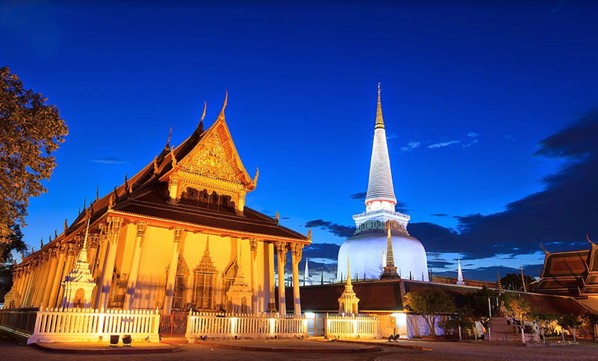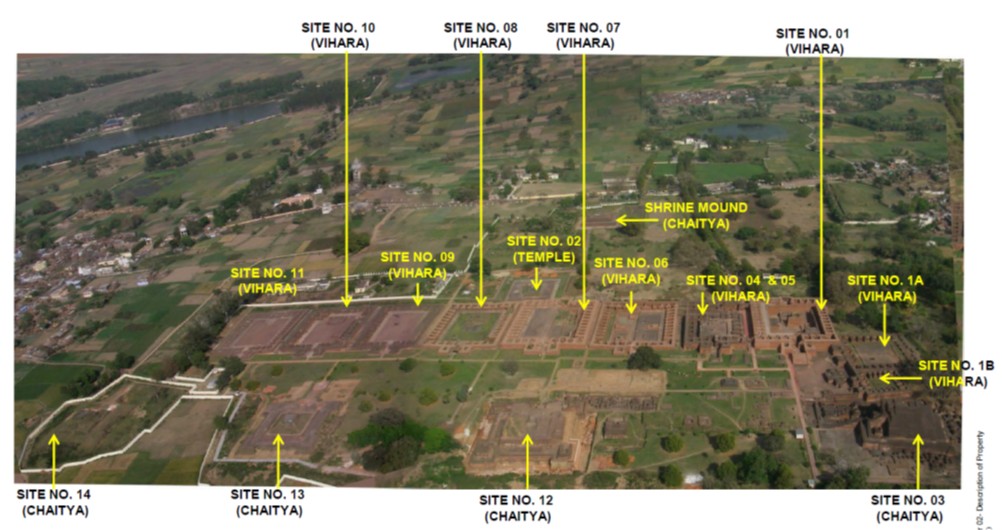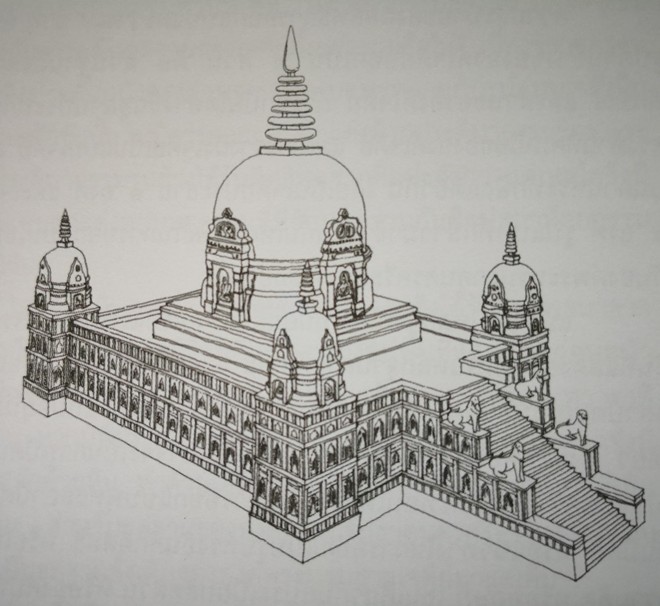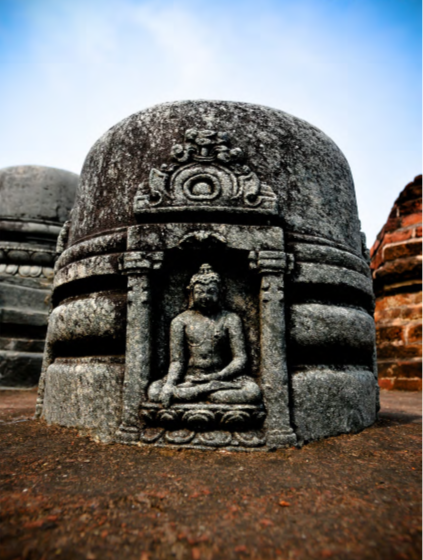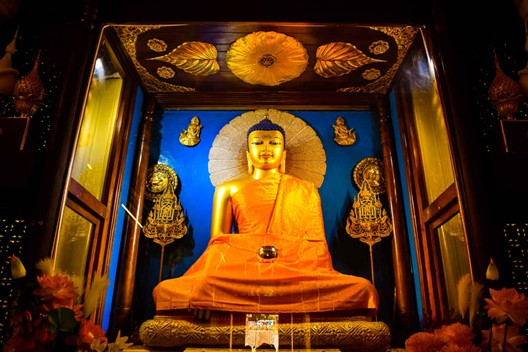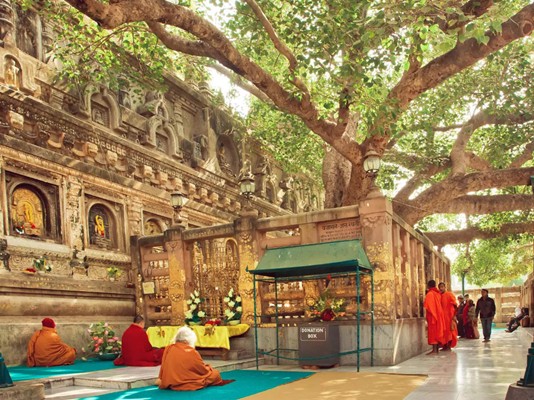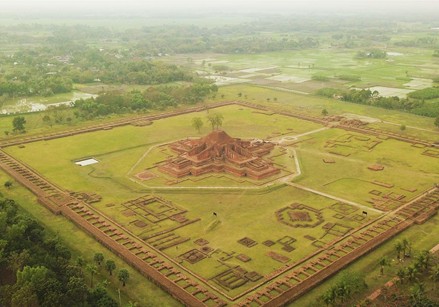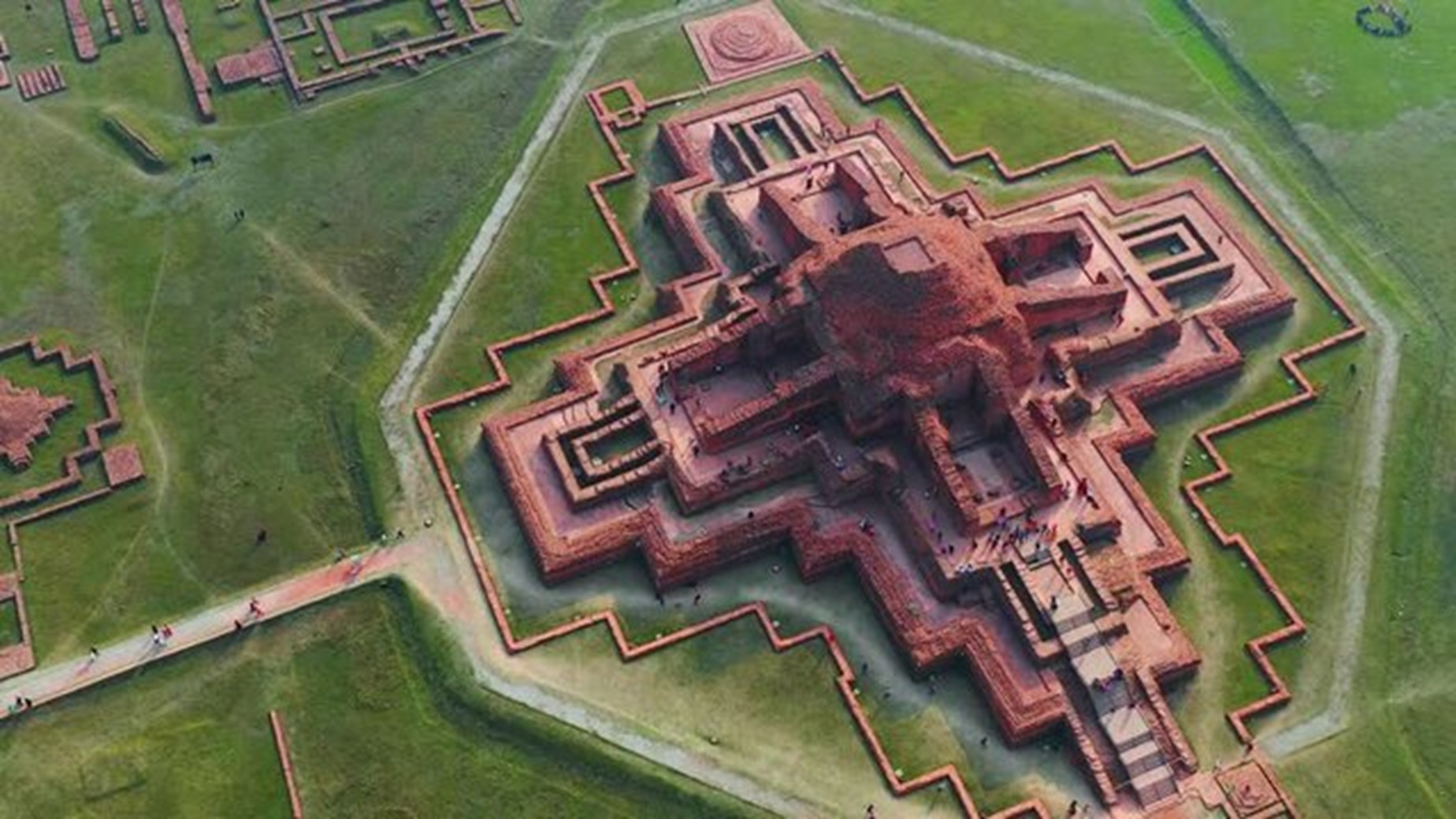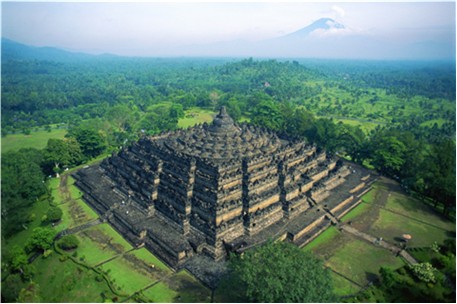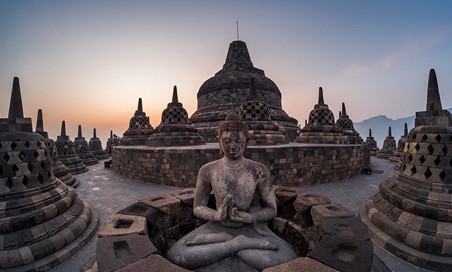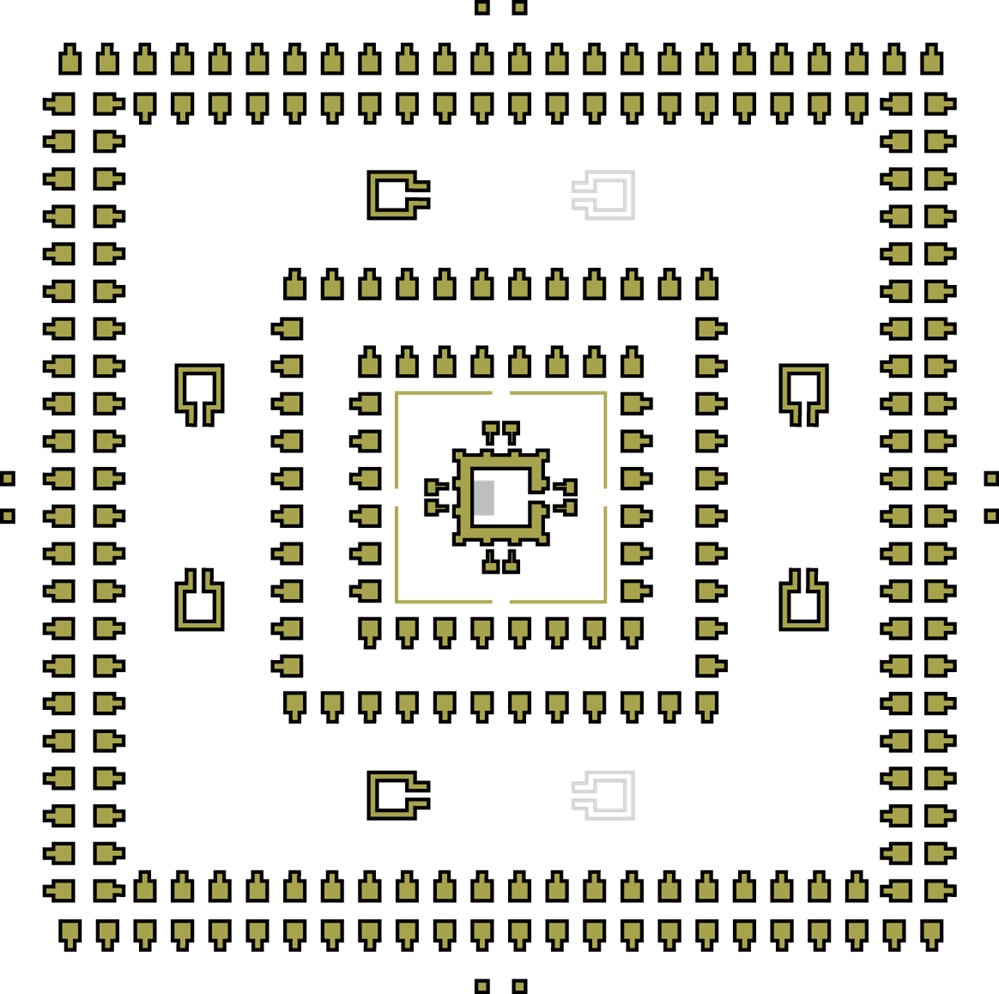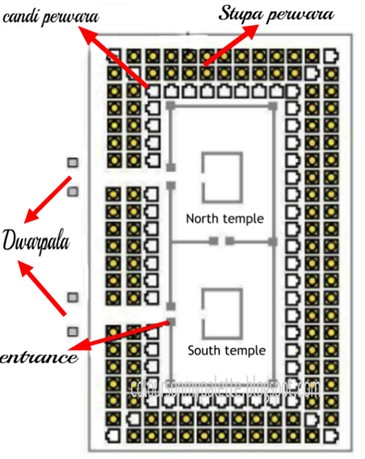Wat Phra Mahathat Woramahawihan, currently a Theravada Buddhist monastery, is an outstanding living testament to the deep-rooted, diverse religious interchanges across the south of maritime Asia. People in South and Southeast Asia utilized the monsoons, which is the largest weather system on earth, to sail from place to place across the vast body of water since the ancient times, carrying
with them valuable goods and cultural cargos, such as religions, languages, and artistic styles. In this context, Wat Phra Mahathat is a universally outstanding site, which has continuously functioned as a living temple representing significant Hindu, Mahayana, and Theravada Buddhist elements from various periods for around 1,500 years.
In the first period (c. the 5th to 8th centuries), some Indian-inspired Hindu vestiges, such as stone inscription, yoni, and architectural parts were found here, indicating that this site was a very early sacred place in Hinduism in Southeast Asia before it was later converted to a Buddhist monastery. Hindu gods and community of priests are still vibrant in the current belief systems and rituals in the Monastery as well.
In the second period (c. the late 8th to 11th centuries), the mandala layout of the Great Reliquary complex which is the longest surviving example of its kind in Southeast Asia, the tubular shape of the Great Reliquary’s dome which is the largest surviving example of its kind in Southeast Asia, the two Bodhi tree shrines (Bodhigara) which is the earliest example of their kinds in Southeast Asia, and the archaeological excavation results, for instance, suggest that this property was an important Mahayana Buddhist temple, localizing architectural forms from Mahayana centers, such as Nalanda in India, Borobudur in Indonesia, and Anuradhapura in Sri Lanka.
In the third period (c. the 12th to 14th centuries), the oversized square platform between the Great Reliquary’s dome and spire, the elephant statues around the Great Reliquary’s base, and the associated textual traditions, for example, demonstrate that the Monastery strongly received cultural elements from Sri Lanka. It then became the epicenter of the so-called Sri Lankan school of Theravada Buddhism and made impacts on various places in Thailand and beyond. For instance, the form of the Great Reliquary influenced that of stupas in Sukhothai, which also continued in Ayutthaya; both were most significant kingdoms in the history of Thailand.
In the fourth period (c. the 15th - mid-18th centuries), Ayutthayan art from central Thailand became influential and numbers of buildings (mostly viharas) were constructed in the Monastery. The finial of the stupa was probably covered in this period with real gold sheets, currently weighting 197.45 kilograms, making it a very rare surviving example of its kind in all South and Southeast Asia, aside from a few stupas in Myanmar. The architectural style of the Great Reliquary was extensively transmitted to many sites, probably including northern Malaysia and southern Myanmar. All these aforementioned elements clearly indicate that the Great Reliquary of Wat Phra Mahathat exhibits outstanding religious interchanges for around 1,500 years in the vast southern part of maritime Asia.
The proposed Outstanding Universal Value of Wat Phra Mahathat is that it is a unique living testament to the diverse religious interchanges across the south of maritime Asia for around 1,500 years, in accordance with Criteria (ii) and (vi). In terms of scope, to be considered similar to Wat Phra Mahathat for the purpose of this particular nomination, each of the cultural heritage sites selected for this comparative study has to meet all of the following specifications:
- The cultural heritage site had to have easy access to and was influenced by the maritime religious interchange across the south of Asia.
- The cultural heritage site has to be inscribed as a Buddhist temple or complex on the World Heritage List or World Heritage Tentative List.
The focus of this analysis is to examine the characteristics of the potential Outstanding Universal Value that each cultural heritage site holds and compare them with those of Wat Phra Mahathat, the nominated property. The selected cultural heritage sites include:
- Archaeological Site of Nalanda Mahavihara at Nalanda, Bihar (India)
- Mahabodhi Temple Complex at Bodh Gaya (India)
- Ruins of the Buddhist Vihara at Paharpur (Bangladesh)
- Borobudur Temple Compounds (Indonesia)
- Rangiri Dambulla Cave Temple (Sri Lanka)
- Shwedagon Pagoda on Singuttara Hill (Myanmar)
|
Fig. 3-1 Wat Phra Mahathat and Its Great Reliquary |
|
Fig. 3-2 Planview of Nalanda Mahavihara |
Archaeological Site of Nalanda Mahavihara at Nalanda, Bihar (India)
Located in the northeastern part of India, close to the deltaic area of the Ganges River, the Archaeological Site of Nalanda Mahavihara had a relatively easy access to the maritime interaction. It is an important Mahayana monastery complex, whose early remains of the temple can be dated from circa the 3rd century BCE. It flourished and became the longest serving monastic cum scholastic center in India from the 5th - 13th centuries before being sacked and abandoned. Its main components include stupas, chaityas, viharas, shrines and many votive structures, which were influential in South and Southeast Asia.
In comparison, ancient kingdoms and temples in maritime Southeast Asia received profound religious and artistic influences from Nalanda, especially in the 8th-11th centuries. Mahayana Buddhism prospered in central Java, southern Sumatra (both in Indonesia) and the Thai-Malay Peninsula during that time. Nalanda exhibits an emergence of a chaitya having quincunxial (five-fold) form, such as that of Stupa No. 3 (Sariputtra Chaitya), which closely inspired the form of the Great Reliquary of Nakhon Si Thammarat. Nevertheless, unlike Wat Phra Mahathat, Nalanda Mahavihara does not seem to have evidence of earlier Hindu shrines or later Theravada temples. It is now a defunct Buddhist center, while Phra Mahathat Monastery has transformed into an outstanding Theravada temple, vibrant and full of living traditions even today. Therefore, in terms of religious diversity, transformation, and continuity in southern maritime Asia, it may be argued that Phra Mahathat Monastery, which is a living Theravada Buddhist temple with Hindu and Mahayana past, can serve as a better example.
|
Fig. 3-3 Layers of Renovations of Stupa No. 3 (Sariputtra Chaitya), Nalanda |
|
แผนผังสถูปหมายเลข 3 ที่ได้รับการสมมุติฐาน (สารีบุตร เจติยะ) นาลันทา |
สถูปหินทรงระฆังคว่ำขนาดย่อส่วน นาลันทา |
Mahabodhi Temple Complex at Bodh Gaya (India)
The Mahabodhi Temple Complex is in the northeastern state of Bihar in India, not very far away from Nalanda and the deltaic area of the Ganges, leading to the sea. It is one of the four most holy sites related to the life of the Buddha, since it is the place where he achieved his enlightenment under the Bodhi tree. The great Buddhist king Asoka first built a temple here in the 3rd century BCE and some remains of it can still be seen, such as the balustrades and a memorial column. The present Mahayana temple dates from the 5th - 6th centuries in the late Gupta period. This 50-meter-high brick temple is one of the earliest Buddhist temples built entirely in brick and is surrounded by numerous votive stupas, buildings, structures, and lotus pond, associated with the events after the Buddha’s enlightenment. The main temple is square in shape, having entrances from the east and the north, and has a low basement with decorated moldings. The temple’s superstructures are divided into several registers with niches and surmounted by amalaka and kalasha. At the four corners of the main temple’s parapet are four Buddha statues in small, towered shrine chambers, altogether forming a quincunxial plan. To the west of the main temple stands a large Bodhi Tree surrounded by a stone fence. It is believed to be the direct descendant of the original Bodhi Tree under which the Buddha attained his enlightenment. It is the most important attribute of this complex.
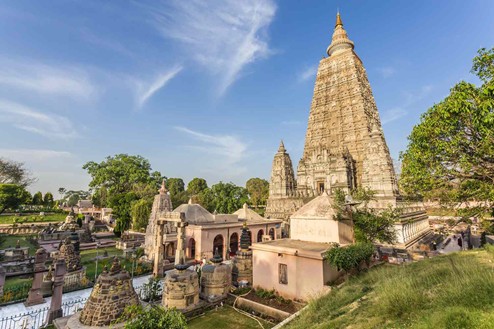
Fig. 3-6 Mahabodhi Temple Complex, Bodh Gaya |
Fig. 3-7 Mahabodhi Temple (interior), Bodh Gaya |
In comparison, Mahabodhi Temple Complex is unquestionably unique as it is the location where the Buddha achieved his enlightenment. Its quincunxial plan is similar to Stupa No. 3 at Nalanda and Wat Phra Mahathat’s Great Reliquary. A descendant of the original Bodhi Tree was planted here, as it was also in Sri Lanka and Wat Phra Mahathat. Nevertheless, the main temple of this Complex dated to the 5th - 6th centuries was of Mahayana Buddhism and became a defunct monastery. Today, the rituals are largely performed by Buddhist pilgrims and visitors, whereas Wat Phra Mahathat is still a vibrant monastery, serving as the religious heart of an important city. Unlike Wat Phra Mahathat, its main temple is a shrine with a sanctum inside, not a solid stupa with the Buddha’s relics, and has never been a Theravada Buddhist monastery. Therefore, in terms of the religious diversity, transformation, and continuity in maritime South and Southeast Asia, it may be argued that Wat Phra Mahathat can serve as a better example in this gap.
|
Fig. 3-8 Sri Mahabodhi Tree, Bodhi Gaya |
Ruins of the Buddhist Vihara at Paharpur (Bangladesh)
Like Nalanda and Bodh Gaya, the ruins of the Buddhist Vihara at Paharpur locates not very far from the deltaic area of the Ganges, through which one could have access to the Bay of Bengal. The monastery was first built for Mahayana Buddhism in the 8th century and became a renowned intellectual center until the 12th century. Today, the brick ruins of the main central shrine is 21 meters high and has a cruciform layout, with three levels of terraces and main entrance to the north. Its intermediate level has a wide circumambulatory path and originally two bands of terracotta plaques. At the base of the shrine, there are over 60 stone sculptures depicting various Hindu deities. Epigraphic records note that this monastery was closely linked to the contemporaneous Bodh Gaya and Nalanda, located in the same general region, where the Vajrayana strand of Mahayana Buddhism was practiced.
|
Fig. 3-9 Buddhist Vihara Complex at Paharpur |
In comparison, the Paharpur temple and the Great Reliquary of Wat Phra Mahathat were both built of bricks and active as Mahayana Buddhist temples in the same period. Though, the main shrine of the Paharpur temple has a cruciform plan, whereas the Great Reliquary has a quincunxial plan. Unlike Wat Phra Mahathat, the Paharpur monastery does not seem to have evidence of earlier Hindu shrines, although it has many Hindu sculptures decorating the Buddhist shrine. Despite its glorious past as the largest Buddhist temple in Bangladesh, this massive temple has been defunct for centuries and does not seem to have traces of Theravada Buddhism. Therefore, in terms of religious diversity, transformation, and continuity in the Bay of Bengal, it may be argued that Wat Phra Mahathat, which is still a vibrant Theravada Buddhist temple with Hindu and Mahayana past and around 1,500 years of history, can serve as a better example of this theme.
|
Fig. 3-10 Main Buddhist Vihara at Paharpur |
Borobudur Temple Compounds (Indonesia)
The Borobudur temple group is located in the southern part of central Java, an island in Indonesia, and was built in the 8th - 9th centuries. This group consists of three monuments situated on a straight east-west axis, including the Mendut, Pawon, and Borobudur temples. Borobudur Temple is the largest in this group and one of the grandest Buddhist monuments in the world. It was constructed with gray andesite stone around a natural hill, serving as its core. It has three tiers, including a pyramidal base with five concentric square terraces, the trunk of a cone with three circular platforms, and a single monumental stupa at the top. Around the circular platforms are 72 openwork stupas, each containing a statue of the Buddha. This vertical division of the temple is believed to be related to the concept of Buddhist cosmology.
In comparison, the shape of the tubular, stout domes of the stupas at Borobudur Temple are similar to those from Nalanda Mahavihara and Wat Phra Mahathat’s Great Reliquary complex, and they were all Mahayana temples in the same period, but only Wat Phra Mahathat still remains as a vibrant Buddhist monastery today. The mandala layout of the three circular platforms with 72 stupas around the topmost stupa at Borobudur Temple probably inspired other temples in central Java, such as Sewu (Buddhist, c. late the 8th century), Plaosan (Buddhist, c. mid the 9th century), and Prambanan (Hindu, c. the 9th century) Temples, which modified Borobudur’s concentric circular platforms into a set of concentric square layers of smaller structures around the main temple on the same flat plain. This mandala square layout is prominently present at Wat Phra Mahathat’s Great Reliquary complex, making it the longest living example of its kind in the maritime Buddhist world. The Great Reliquary’s tubular, stout dome (9.8 meters high) is also nearly twice the size of that of the main, topmost stupa at Borobudur Temple (5 meters high). Despite its grandeur and the testament to the flowering of Mahayana Buddhism in Southeast Asia, Borobudur Temple is now a defunct monastery and does not seem to have evidence of earlier Hindu shrines or traces of Theravada Buddhism. However, its legacy lives on in the living architecture of Wat Phra Mahathat. Therefore, in terms of religious diversity, transformation, continuity, and longevity in maritime Southeast Asia, it may be argued that Wat Phra Mahathat, which is still a vibrant Theravada Buddhist temple with Hindu and Mahayana past and around 1,500 years of history, can serve as a better example.
|
Fig. 3-11 Borobudur Temple |
Fig. 3-12 Mandala Layout of Borobudur Temple |
|
Fig. 3-13 Topmost Stupa with Tubular Dome Shape and Satellite Stupas with Buddha Images, Borobudur Temple |
Plan 3-1 Mandala of Sewu Temple |
|
Plan 3-2 Mandala Layout of Plaosan Temple |
Draft Statement of Outstanding Universal Value
a) Brief Synthesis
Located in peninsular Thailand between the Indian and Pacific Oceans, Wat Phra Mahathat Woramahawihan. Nakhon Si Thammarat is an outstanding living testament to the deep-rooted, diverse religious interchanges across the south of maritime Asia. People in South and Southeast Asia utilized the monsoons to sail from place to place across the vast body of water since the ancient times, carrying with them valuable goods and cultural cargos, such as religions, languages, and artistic styles. In this context, Wat Phra Mahathat is a universally outstanding site, which has continuously functioned as a living temple representing and syncretizing significant Hindu, Mahayana, and Theravada Buddhist elements from various periods for around 1,500 years.
As a crucial religious link in maritime Asia, Phra Mahathat Monastery has the Great Reliquary of the Buddha in the form of a massive stupa at its center and an impressively long history. The Monastery exhibits four main periods, in which the religious and architectural interchanges with other countries can be clearly observed, as follows. In the first period (c. the 5th-8th centuries), some Indian-inspired Hindu vestiges, such as stone inscription, yoni, and architectural parts were found here, indicating that this site was a very early sacred place in Hinduism in Southeast Asia before it was converted to a Buddhist monastery. Hindu gods and community of priests are still vibrant in the current belief systems and rituals in the Monastery as well. In the second period (c. the late 8th-11th centuries), the mandala layout of the Great Reliquary complex which is the longest surviving example of its kind in Southeast Asia, the tubular shape of the Great Reliquary’s dome which is the largest surviving example of its kind in Southeast Asia, the two Bodhi tree shrines (Bodhigara) which are the earliest known and longest living examples of their kind in Southeast Asia, and the archaeological excavation results, for instance, suggest that this property was an important Mahayana Buddhist temple, localizing architectural forms from Mahayana centers, such as Nalanda in India, Borobudur in Indonesia, and Anuradhapura in Sri Lanka. In the third period (c. the 12th-14th centuries), the oversized rectangular platform between the Great Reliquary’s dome and spire, the elephant statues around the Great Reliquary’s base, and the associated textual traditions, for example, demonstrate that the Monastery strongly received cultural elements from Sri Lanka. It then became the epicenter of the so-called Sri Lankan school of Theravada Buddhism and made impacts on various places in Thailand and beyond. For example, the form of the Great Reliquary influenced that of stupas in Sukhothai and continued in Ayutthaya. In the fourth period (c. the 15th- mid-18th centuries), Ayutthayan art from central Thailand became influential and a number of buildings were constructed in the Monastery. The finial of the stupa was probably covered in this period with real gold sheets, currently weighting 197.45 kilograms, making it a very rare surviving example of its kind in all South and Southeast Asia, aside from a few stupas in Myanmar. The architectural style of the Great Reliquary was extensively transmitted to many sites, probably including northern Malaysia and southern Myanmar. All these aforementioned elements clearly indicate that Wat Phra Mahathat exhibits outstanding religious interchanges for around 1,500 years in the vast southern part of maritime Asia.
As the religious heart and the spiritual center of the old Nakhon Si Thammarat Kingdom, its capital city, and the province of the same name today, Wat Phra Mahathat is well-preserved and traditionally maintained by the local community and the government, has a substantial size, and retains its authenticity, wholeness, intactness, and living traditions. Diverse living traditions continue to imbue the Monastery with authentic spirit that cannot be easily separated between sacred and secular practices. For instance, the annual cloth-wrapping ceremony for the Great Reliquary is a remnant of the ancient influence from Sri Lanka, but it has surpassed that of Sri Lanka in terms of scale and is widely considered the inspirer of such ceremony in all Southeast Asia. The Nora, dance drama in southern Thailand, which was already fully recognized by UNESCO as the Intangible Cultural Heritage of Humanity, is still performed at the Monastery on special occasions and possesses old oral invocations to praise and pay homage to the Great Reliquary. Wat Phra Mahathat has an exceptional temple museum, safeguarding 32,656 artifacts and artworks; most of them are offerings from laypeople to the Monastery, indicating the continued faith in this living property, and among them, 84 artworks have already been registered as national treasures announced in the Royal Gazette and protected by the government. The Great Reliquary is also the centerpiece of the local chronicles inspired by the 13th century Pali texts from Sri Lanka and considered one of the earliest and most remarkable oral/textual traditions in Thailand. Local people still chant these chronicles on special religious days at Wat Phra Mahathat. All these elements strongly indicate that Wat Phra Mahathat is directly and tangibly associated with living traditions of outstanding universal significance.
b) Justification for Criteria
Criterion (ii)
Wat Phra Mahathat remarkably exhibits religious diversity, spiritual continuity, and vital elements which capture the waves, art forms, and essence of all important religions, including Hinduism, Mahayana Buddhism, and Theravada Buddhism, transmitted across the south of maritime Asia for around 1,500 years. It has possessed and synthesized a great variety of significant architectural styles influential in this region. The Pala art from Nalanda, central Javanese art, Sri Lankan art, and Mon art of southern Myanmar had all made their tangible presence on the Great Reliquary complex, making it an outstanding living example of the religious and architectural interchanges of human values. The architectural forms, Buddhist practices, and living traditions of Wat Phra Mahathat also made significant impacts on other places in Thailand, Malaysia, and beyond.
Criterion (vi)
Wat Phra Mahathat is the religious heart of the isthmian city and spiritual center of living traditions with diverse belief systems that have been syncretized with the prior indigenous beliefs and later Hinduism and Buddhism, as witnessed in daily practices, merit makings, and annual ceremonies. The uniqueness of living traditions at Wat Phra Mahathat, such as the annual cloth-wrapping ceremony for the Great Reliquary, shamanic Nora dance, ancestor worship, Brahminic rituals, rare artworks, and local chronicles, vividly represents relationships between this sacred site and its surrounding communities and inspires other monasteries and communities in Thailand and beyond.
c) Statement of Integrity
The proposed boundaries of the property respect the historic outline of Wat Phra Mahathat and include all the necessary monuments to demonstrate the adaptation of religious architecture and temple layout from diverse places in the south of maritime Asia, such as India, Java, and Sri Lanka, and to exhibit the Monastery’s architectural influence on subsequent religious architecture in Thailand and beyond. These attributes embody its Outstanding Universal Value. The property, which is the precinct of Wat Phra Mahathat, is of 5.356 hectares and the buffer zone covers an area of 113.136 hectares, affirming that it has a substantial size. As a living Buddhist monastery, the wholeness of this property has been kept intact by the fact that it has both the sanctuary and residential sections for the monks surrounded by solid walls of the Monastery. The Great Reliquary complex and its surrounding religious buildings were at the center of the Monastery, flanked with residential quarters for the monks in the north and south on an ancient beach ridge.
In terms of intactness, the property maintains a good state of preservation and has adequate protection. The property and its buffer zone have been traditionally protected by the local community and formally under a range of legislations, which preserve both the Monastery and its ancient town. The modern urban development has no negative impact on the area inside the Monastery, because this property has been respected as the City’s spiritual center and preserved for mainly religious purposes. Therefore, this property exhibits a very high degree of integrity, which is ensured in the contexts of both wholeness and intactness.
d) Statement of Authenticity
The nominated property retains a high level of authenticity in terms of form, materials, traditions, location, function, and spirit. In terms of form, Wat Phra Mahathat Monastery has captured diverse architectural influences in the south of maritime Asia and still exhibits their authenticity. The Great Reliquary complex has still authentically preserved its architectural mandala layout, its tall base and tubular, stout dome, and its Bodhi tree shrines, as they were first constructed in c. the late 8th-early 10th centuries, making it the longest living example of all these attributes in the maritime Buddhist world. The large, square platform between the dome and the spire of the Great Reliquary and the elephant niches around its base still uniquely display the Sri Lankan influence from c. the 12th-13th centuries. The buildings (viharas) with wooden superstructures from the Ayutthaya and Bangkok periods have been traditionally renovated, but still sufficiently maintain their original forms.
The authentic layout of circa the late 8th-early 10th century is still preserved today, in which the Great Reliquary and its stairway are in alignment with the main Bodhi tree shrine (Pho Langka Vihara) and other viharas along the way in the north-south axis. The majestic, living Bodhi tree is still called Pho Langka, meaning the Sri Lankan Bodhi tree, and believed to be planted from a sapling of Maha Bodhi Tree in Sri Lanka, which in turn was a direct descendant of the Maha Bodhi Tree in Bodh Gaya in northeast India, under which the Buddha attained his enlightenment some 2,500 years ago. The two Bodhi tree shrines at Wat Phra Mahathat are the earliest known and longest living examples of their kind in all Southeast Asia and the Bodhi trees they enshrined have repeatedly been replanted from saplings of the original trees when they perished, keeping the authentic tradition alive in the form of a tangible living tree and indicating unbroken continuation for around 1,300 years.
In terms of material and traditions, the Great Reliquary complex and the foundations of its surrounding buildings are of brick masonry and the subsequent conservations by the local community and government used lime mortar as it was traditionally employed in the past. In terms of location/setting, Wat Phra Mahathat was prominently constructed as the religious heart of the City on an ancient beach ridge, which the local chronicles and people called the Crystal Beach, where the Buddha’s relics were buried. In the memory and religious imagination of the people, the Great Reliquary and the Crystal Beach could not be separated. It was the magical quality of the pure, white sand that attracted the legendary royal siblings to this place and buried the Buddha’s relics here, even before the construction of the Great Reliquary. It is the sacredness that emerged from the magical landscape. Today, the broad sand ground is still preserved in front of the Great Reliquary on the eastern side, creating remarkable scenery, which could not be found anywhere else in the urban area. In terms of use/function and spirit/feeling, Phra Mahathat Monastery is still functioning as a living monastery, full of unique living traditions and genuinely maintaining its original purpose as the religious center of the City. The separation between the sanctuary and monastic residential sections is authentically in accordance with the spatial organization instructed in the Tipitaka. The surrounding buildings were also built to create the atmosphere of Buddhist paradise and used for regular communal rituals by monks and devotees, some of whom came from other countries, such as Malaysia. The continued vibrancy of its spirit as a sacred place for around 1,500 years exhibits a high level of authenticity and is outstanding in the world.
e) Requirements for Protection and Management
Diverse mechanisms have been implemented to ensure the effective protection and sustainable management of Wat Phra Mahathat, its buffer zone, and its proposed Outstanding Universal Value. These mechanisms include consistent and proportionate enforcement of legislations and close collaboration with local communities and all parties involved. As an important ancient religious site and living monastery, the nominated property protected by a range of legislations. It has been declared a significant national heritage site, listed in Royal Gazette, Volume 53, Page 1530, on the 27th September 1936, and Fine Arts Department has designated the area of the Ancient Monument in Royal Gazette, Volume 141, Special Issue 130 Ng, Page 7, on the 9th May 2024, covering the entire monastery area. The protection, management, and conservation within the nominated property are safeguarded by two Acts:
- Act on Ancient Monuments, Antiques, Objects of Art, and National Museums Act 2504 B.E. (1961), amended the 2nd edition 2535 B.E. (1992), is overseen by Fine Arts Department through the 12th Regional Office of Fine Arts, Nakhon Si Thammarat, which is responsible for conserving and restoring all ancient monuments within the monastery.
- Sangha Act, 2505 B.E. (1962), is overseen by Sangha Supreme Council of Thailand and National Office of Buddhism, under the Prime Minister's Office. According to Section 37, which designates the abbot as responsible for maintaining the monastery's properties and religious affairs, ensuring that monks and laypeople residing within the monastery follow the Buddhist precepts and regulations, and facilitating appropriate religious practices.
The buffer zone of the nominated property is sufficiently sizable to protect and maintain Phra Mahathat Monastery’s Outstanding Universal Value. It overlaps with two ancient cities historically associated with the Monastery and is currently a modern urban area. This buffer zone is protected and managed according to four relevant official regulations:
- Announcement of the Committee for the Conservation and Development of Rattanakosin City and Old Towns, 2553 B.E. (2010), under the authority of Clause 9(1) of the Office of the Prime Minister’s Regulations on the Conservation of Rattanakosin and Old Towns, 2546 B.E. (2003), and the Cabinet Resolution of the 9th November 2010, designates the Old Town of Nakhon Si Thammarat, covering an area of 378.900 hectares. Office of Natural Resources and Environmental Policy and Planning, under Ministry of Natural Resources and Environment, serves as the secretariat of the committee, overseeing the area, which includes the ancient city and surrounding communities, encompassing Nakhon Si Thammarat ancient town, Phra Wiang, and Tha Wang historic communities.
- Announcement of Nakhon Si Thammarat General Plan, 2562 B.E. (2019), under the Town Planning Act, is overseen by the Department of Public Works and Town & Country Planning. This plan regulates land use, including conservation measures to promote the area's cultural identity. The nominated property and its buffer zone are included within the old town boundary of Nakhon Si Thammarat, dating back to the Ayutthaya period, encompassing the city walls and moat, with an area of 97.139 hectares.
- The Nakhon Si Thammarat Municipal Law, 2563 B.E. (2020), issued by the Nakhon Si Thammarat Municipality, covers the nominated property and its buffer zone, which corresponds to the old town boundary of Nakhon Si Thammarat from the Ayutthaya period. The area is 97.139 hectares, in accordance with the Nakhon Si Thammarat General Plan. These regulations include measures to control the height and design of buildings and prohibit the construction, modification, or change of use for certain types of buildings within this area under the municipality’s jurisdiction
- Provincial Land Traffic Officer’s Announcement of Nakhon Si Thammarat province, concerning the regulation of speed limits on roads within Nakhon Si Thammarat Municipality, under Sections 67 and 139(6) of the Land Traffic Act, 2552 B.E. (2009), and the Ministry of Interior Order No. 529/2555 dated the 7th September 2012, appoints traffic officers according to the Land Traffic Act, 2522 B.E. (1979). This order aims to control speed and weight limits on Ratchadamnoen Road, from Hua Road Intersection in Nai Mueang sub-district to the three-way intersection at the Provincial Stadium in Tha Wang sub-district, Mueang district, Nakhon Si Thammarat province. This aligns with the conservation approach for the historic city.
Protection activities have been carried out by governmental agencies at all levels, with Nakhon Si Thammarat provincial government and Fine Arts Department overseeing overall implementation and enforcing the relevant legislations and regulations. Since Wat Phra Mahathat is a living religious center, a firm collaboration between Wat Phra Mahathat, Nakhon Si Thammarat province, Fine Arts Department, and the local communities to manage the property and create holistic strategies for protection has been continued. Focus have been on conservation, improvement of surrounding environment, tourism management, environmental management and approaches on how to increase awareness and understanding and effectively enforce local government legislations. The long-term goal and expectation are that local communities, including monks, laypeople, and the City’s residents, will be upskilled and capable of constructive involvement in the sustainable protection and management of Phra Mahathat Monastery in the long run.



